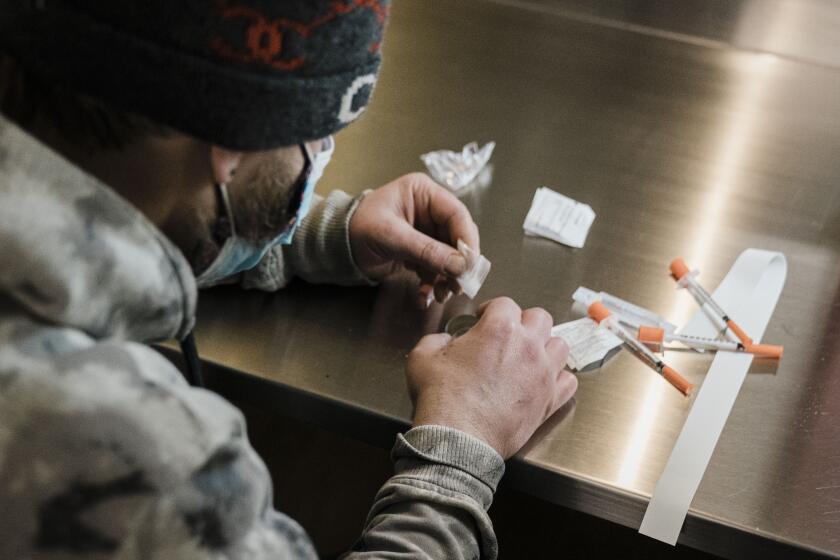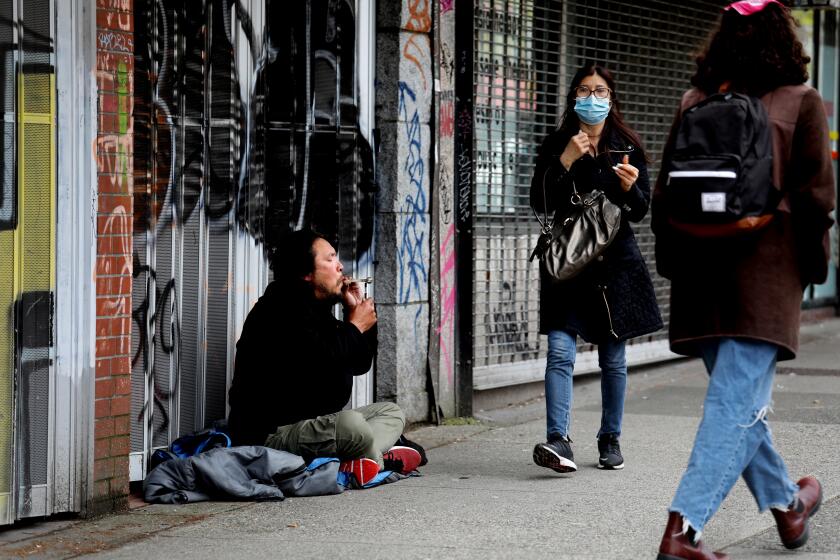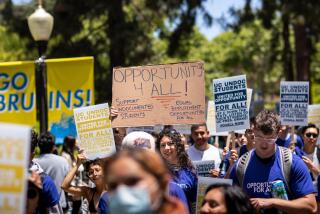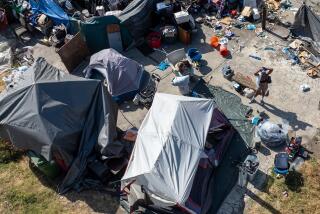Column: With Newsom’s veto of safe consumption sites, our ugly war on drugs deepens
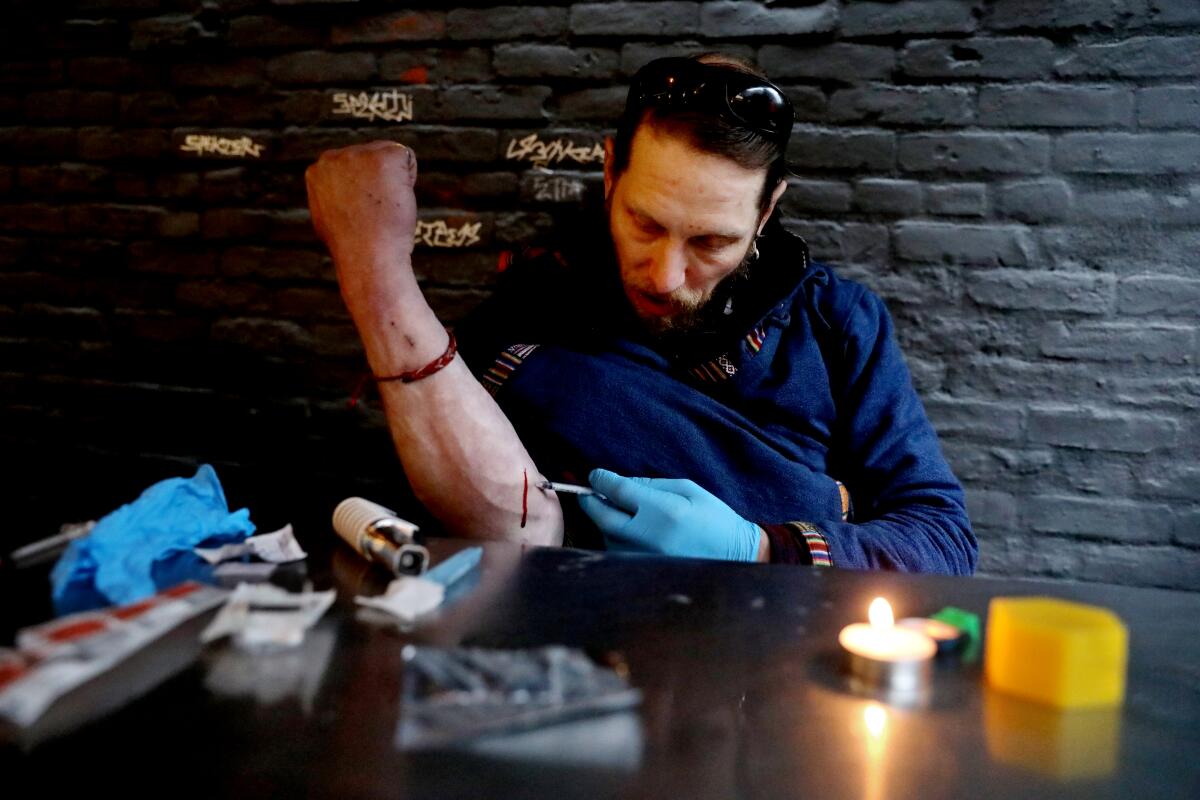
SACRAMENTO — Remember how great the last war on drugs was?
How in the 1980s, we criminalized addiction and filled jails and prisons with Black and brown people, certain we could punish our way out of the crack epidemic — eventually reaching the point where 1 of every 3 Black men in America between the ages of 20 and 29 was incarcerated, on parole or on probation?
How we split apart families and sent a generation of kids into foster care rather than helping their moms get treatment?
How rich drug users were shielded from scrutiny inside their homes, glamorized for hit Hollywood films, while their poor counterparts were vilified as hookers, thieves and gangbangers?
Our obsession with all things ’80s seems to have leapt from entertainment to public policy this week with the veto by Gov. Gavin Newsom of Senate Bill 57, which would have allowed Los Angeles, San Francisco and Oakland to open monitored safe drug consumption sites — at a time when 18 Californians on average die each day from an opioid overdose, 6,843 lives lost in 2021.
We’ve dabbled with what experts call a “harm reduction” approach to addiction, led by the philosophy that people need treatment, not cells. But the feet of our political leaders have turned icy cold, and they’re hightailing it back in to more familiar ground.
California, meet the new drug war, same as the old drug war in too many troubling ways.
Don’t expect this one to be any more successful.
In the last year, we’ve seen politicians across our state and at all levels of government react to our frustration with homelessness, addiction and a lack of affordable housing with the easiest and least effective of policy solutions: crackdowns.
Crackdowns on crime. Crackdowns on encampments. Crackdowns on low-level dealers and users and street vendors just trying to sell some bacon-wrapped hotdogs. Crackdowns on illegal guns (OK, that one is good) and street gangs and sleeping on sidewalks near schools. The DMV even had a crackdown on illegal auto dismantlers.
Our politicians want us to know they are getting tough, taking this seriously, making change happen — though the truth is, it’s the same recycled failures, softened some by current mores, but no more effective than it’s ever been. Crackdowns mean criminalization, which means incarceration — and the endless churn of our most vulnerable citizens sucked in and spit out by the justice system over and over again.
Already, police in San Francisco have returned to citing people for possession of drug paraphernalia, a tactic straight out of 1984, championed by Mayor London Breed, who has embraced the crackdown carnival by declaring one in the Tenderloin earlier this year. At the same time, the suburban crisis of teens buying pills on Snapchat and dying in their bedrooms, a tragedy I diminish in no way, is treated entirely differently.
Of course, many of our criminal justice reforms can’t be undone so easily and offer protection from a true return to lock-’em-up justice. And our acknowledgment of the systemic racism perpetuated by old drug laws — such as harsher penalties for crack than cocaine — should require that we think twice before increasing punishments for dealing fentanyl and new variations of ever-deadlier drugs.
But the mentality that led us to follow another Californian, Ronald Reagan, deeper into the war on drugs — a misguided need for performance over substance from politicians — is bubbling to the surface like sludge from a backed-up drain.
In his veto message on SB 57, Newsom said he has “long supported the cutting edge of harm reduction strategies,” but was nixing this pilot program because while it “is possible that these sites would help improve the safety and health of our urban areas,” the risk of “unintended consequences was too great.”
Gov. Gavin Newsom faced a political challenge with Senate Bill 57, intended to curb overdose deaths in California through safe injection sites.
He is, however, ordering that cities and counties come up with standards and best practices for open consumption sites and will “remain open” to future proposals after that study is done. Likely long after he’s out of the governor’s office.
Newsom has said he’s most certainly, absolutely not running for president, but he clearly is contorting into all sorts of policy triangulations to give himself options, should opportunity present itself.
Why else would he aim his press coverage far outside our Golden State? Most recently, his ads targeting Florida Gov. Ron DeSantis and Texas Gov. Greg Abbott (and their responses) have given all three men a glorious bounce in their ability to reach a larger prospective base. One recent poke by our governor, dropped as part of “our new series of Hypocrite or Fraud,” shows a more relaxed, less jargon-infused Newsom attacking DeSantis over his stance against vaccine mandates, pointing out that Florida requires seven shots before children can attend public schools.
I get the personal logic of the veto. Opening safe drug consumption sites would be like handing a club to his political foils and asking them to bash his future. The Fox News chyrons write themselves. Newsom legalizes hard drugs. Failed California opens drug dens. Newsom to addicts: The streets are yours!
Tucker Carlson would have a blast. As politics, safe consumption sites are a loser for Newsom. This veto is the clearest signal yet that he envisions a presidential run one day and has no intention of mucking up his chances with anything that could complicate his success.
Policy, however, is a different beast — one best fed on a diet of courage and clarity. There is nothing courageous in this veto, and the reasoning for it is overflowing with expediency. If saving lives matters, safe consumption sites are a necessity while we figure out the rest — the same way homeless shelters are a stopgap need while we build housing.
To be honest, until I visited such safe sites in Vancouver, where they have been running for decades, I was against them. They sound gruesome, and in truth, they can be hard to witness. It is a room full of people smoking and injecting heroin, meth, fentanyl or combinations that would kill most of us with a single dose, but to which many of these struggling humans have built a terrible tolerance.
For years, this Canadian city has hosted safe consumption sites for addicts. They’ve saved lives, but with some painful tradeoffs.
Should they quit? Absolutely. Should addiction be a death sentence? No.
All safe injection sites do is keep a user alive one more day, in the hopes they stay breathing long enough to make the decision to stop using. That’s it. They are just triage centers for people who are wounded. If no one dies inside a safe consumption site, it is a success.
But I think politicians including Newsom are reading us wrong. Yes, we are tired and heart-weary of what we see on our streets. Yes, we want change. We don’t want needles in our playgrounds, smashed car windows or unconscious drug users sprawled on our sidewalks.
I don’t think many Californians want to go back to the war on drugs, though, or want to see those with substance use disorders criminalized or killed by indifference. That makes us tired too.
I think we want policies that work. And although it may not play in Kansas, Californians are sophisticated enough to understand that some fixes aren’t pretty. The veto of safe consumption sites won’t curtail drug use any more than arresting drug users will. But it does cost lives.
The bill’s author, Sen. Scott Wiener of San Francisco, said after the veto that he probably won’t bring back the idea unless the governor’s position changes. In the meantime, about 6,000 Californians — if not more — will continue to die of an overdose every year.
In our new war, or maybe just in this continuing war that never really ended, those lives are collateral damage — victims as much of politics as of drugs.
More to Read
Sign up for Essential California
The most important California stories and recommendations in your inbox every morning.
You may occasionally receive promotional content from the Los Angeles Times.
